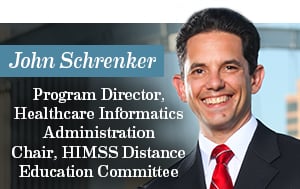Originally published in Journal of Healthcare Information Management, Fall 2012, Volume 26, Number 4
 The healthcare landscape changes quickly and successful organizations must adapt quickly if they hope to be competitive and profitable. Unfortunately, larger, more complex organizations seem to have a hard time implementing change.
The healthcare landscape changes quickly and successful organizations must adapt quickly if they hope to be competitive and profitable. Unfortunately, larger, more complex organizations seem to have a hard time implementing change.
In his book The Fifth Discipline, Senge introduces the concept of mental models, telling us that organizations fail to adapt and change because “new insights fail to get put into practice because they conflict with deeply held internal images of how the world works.”5(p. 174) As a result each stakeholder group has a different mental model: administrators tend to view changes in terms of how they affect profitability; clinical staff are focused on the impact on patient care; and health IT staff are focused on providing business functionality.
These mental models cause each group to focus on activities that occur in their own silo, often without consideration for how these changes will impact others in the organization.
As healthcare organizations race to meet the Meaningful Use deadlines introduced in the American Recovery and Reinvestment Act (ARRA) and address a variety of other initiatives such as accountable care organizations (ACO) and the patient centered medical home, they must learn to break down silos to achieve success. When stakeholder groups function in their silos they tend to oversimplify the activities of other stakeholder groups and thus underestimate the impact of their activities on the other groups.
Success in a rapidly changing healthcare marketplace does not depend on embracing new mental models for operating within the silos, rather it depends on breaking down the silos and developing new mental models for operating across organizational silos. Senge tells us that “the healthy corporations will be the ones which can systematize ways to bring people together to develop the best possible mental models for facing any situation at hand.”5(p. 181)
Recognizing the Silos
For the purpose of this paper three stakeholder groups (silos) will be discussed: clinical, IT and administration. All three of these groups are crucial to the success of modern healthcare organizations and rely heavily on one another to achieve their goals. The challenge in managing this interdependence is that while each group is aware of its dependence on the others, they often fail to understand how important they are in helping the other groups achieve their respective goals. The first step to understanding this issue is to examine each silo group and views their role in fulfilling the organizational mission.
The clinical silo. For clinical staff, patient care is paramount, aiming to deliver compassionate, high quality care to their patients. Their desire to constantly deliver better care and improve patient outcomes has driven tremendous improvements in healthcare delivery.
In 2010, the New York State Department of Health (NYSDOH) reported a 15-percent decrease in surgical site infections for the period from 2007-103(p. 4) and a 37 percent reduction in ICU central line infections.3(p.9) In addition, to deliver better care and improved outcomes for the patient, these advances are estimated to have saved between $15.2 million to $52.5 million dollars in healthcare costs.3(p. 89)
Often clinicians are viewed by other stakeholder groups as being resistant to change and unconcerned with costs, but the NYSDOH report offers evidence to the contrary. In their quest to deliver quality patient care they will embrace changes in equipment, technology and processes that they believe will lead to improved patient care. Likewise, clinicians will resist changes they believe are a distraction or interfere with patient care.
The Administrative Silo
Healthcare administrators are charged with managing the business of healthcare. This is often an unpopular task because staff prefer to identify with the noble purpose of healing the sick and saving lives, but the reality is healthcare is a business. National Health Expenditures (NHE) are rising at a dramatic rate and healthcare administrators are under increasing pressure to bring down cost. According to a 2008 CMS report, the per capita NHE rose from $5,967 in 2003 to $7,421 in 2007, and is projected to reach $13,100 by 2018.8
Hospital administrators are often perceived as solely concerned with profitability at the expense of patient care. The reality, however, is that administrators are facing rising labor, technology and other costs often while being squeezed by declining profits. Administrators are interested in promoting healthcare quality and leveraging technology to achieve a competitive advantage, but must keep the organization profitable. A December 2010 report showed that while overall hospital profit margins were positive, 38 percent of all hospitals were operating with a negative profit margin.7
The Information Technology Silo
The information technology silo is an area that is growing increasingly important. With the onset of electronic medical records (EMR) and health information exchanges (HIE), information technology has transitioned from a tool to facilitate business functions to playing a critical role in how healthcare is delivered. The changing role of IT in healthcare is central to the future success of all healthcare organizations. A report by the Technology Informatics Guiding Education Reform (TIGER) Initiative noted: “Information technology should provide evidence-based, patient-centric technology that allows interdisciplinary collaboration at the point-of-care.”6(p 23)
IT staff recognize their importance to the future of healthcare and are committed to providing reliable, efficient access to technology. The challenge for IT staff is that they often view technology from a functional standpoint rather than considering how the application of technology impacts the workflow of the user. Technology function focuses solely on systems working as designed rather than ease of use. The TIGER Initiative report described it this way: “…much of this technology was not designed to support nursing work or thought processes…IT should be an enabler versus a barrier.”6(p 23)
Breaking Down the Silos
Each of the silos plays an important role in the success of the organization. Each of them is also important to the other fulfilling their purpose within the organization, but too often they are put at odds with each other and are forced to compete to achieve their individual goals.
The irony of this is that all three stakeholder groups are guided by the same organizational mission, vision and goals but somehow each develops its own goals and these goals are often inconsistent with one another. As healthcare organizations race to meet the looming Meaningful Use deadlines clinical staff, administration and IT departments are being stretched to their limits.
As the name implies, Meaningful Use is about much more than implementing an expansive clinical information system, it is about using that information system to transform the way healthcare is delivered
in the United States.
Cooperation is not enough to accomplish transformation, success depends on collaboration. There is a significant difference between cooperation and collaboration. When each stakeholder group has its own goals, but is dependent on another group, they cooperate with one another to accomplish their goals. Cooperation tends to be short term and transactional in nature, focused on each group getting something they want from the transaction. Collaboration is a different paradigm where two or more groups must work together over time to accomplish a shared goal. The only way to achieve the shared goal is to cease functioning as two separate groups and begin to operating as a cross-functional team.
Cooperation vs. Collaboration
To illustrate the problem with cooperation consider how each of the stakeholder groups might approach a project to implement a clinical information system. Clinical staff will focus on how the information system integrates into their existing workflow to provide improved patient care. IT staff will focus on how to provide the required functionality in a reliable and efficient fashion. Administrative staff will focus on how to contain project costs, and more accurately capture billable services and expedite billing. When viewed independently all three groups have very reasonable project goals that are consistent with their role in the organization. The problem is that these goals encourage competition, rather than teamwork. To achieve these goals the three groups will cooperate with one another to bring in a lower cost system with less functionality that does not integrate well with the clinical environment.
This scenario is consistent with three of the problems that Ozeran identifies as common causes of EMR project failures: ignoring end-user requirements, inadequate budget and failure to implement process change.4 As a result, no one is really happy with the system, but it meets some of everyone’s goals.
Collaboration is quite different that cooperation. Collaboration requires a shared vision that helps all stakeholders understand the importance of the project to the success of the organization. The vision must paint a picture of how implementing the clinical information system will transform the way healthcare is delivered providing clinicians with better access to information and patients with better, more cost effective care. The goals must be shared goals so that everyone on team has a common purpose and is not focusing achieving one goal possibly at the expense of another. Once this happens everyone involved will be open to exploring new mental models that challenge the current process, but achieve the vision.
The Leader’s Role
The leader’s role is perhaps the most important in bringing about organizational transformation, which is why many organizations fail. Too often leaders believe their job is to create a vision, share the vision, and define goals that must be achieved in order to achieve the vision. Once this is done they simply monitor their followers’ progress, reward good results and impose consequences for poor results. This is transactional leadership where followers do what the leaders ask in exchange for rewards or to avoid negative consequences.
While this may be adequate to maintain the status quo, it is the personification of the quote often attributed to Albert Einstein that “insanity is doing the same thing over and over again and expecting different results.” Organizational transformation requires transformational leadership.
Transformational leadership is based on a leader’s relationship with their constituents and his or her constituents’ relationship with each other. In their book The Leadership Challenge, James Kouzes and Barry Posner describe five ways that exceptional leaders are able to accomplish this challenging task and build meaningful relationships with their constituents.2
to act. 2(pp 21-22)
Collaboration and Meaningful Use
While the guidance given by Kouzes and Posner is sound advice to leaders in any industry, it becomes particularly relevant to organizations pursuing Meaningful Use. Meaningful Use, as its name implies, is much more than implementation of an EMR; it requires using the EMR in a meaningful way to improve patient care and lower the overall cost of healthcare. In their book Beyond Implementation, Haugen and Woodside list a number of common indicators that EMR adoption is at risk. They cite a singular focus on the go-live event, having the IT executive as the primary project owner, disengaged leadership, and a lack of planning for post go-live workflow changes.1 All of these indicators are the result of internal competition resulting for a lack of transformational leadership and the competing goals that result. When collaboration occurs and stakeholder groups are driven by a shared vision and goal it becomes difficult for the obstacles cited by Haugen and Woodside to take root.
Conclusion
Accomplishing the shared vision of delivering compassionate, cost effective, quality care using an information systems platform is possible when organizational silos are broken down. As these barriers are broken down new mental models will emerge, helping organizations adapt and change. Meaningful Use is just the first of many challenges looming on the horizon. Organizations fostering teamwork and collaboration that transcend stakeholder groups will have a significant competitive advantage in the marketplace.
Additional Reading
Sources
- Haugen HA, Woodside JR. (2010). Beyond Implementation: A Prescription for Lasting EMR Adoption. Denver, CO: Magnusson Skor Publishing.
- Kouzes JM, Posner BZ. (2007). The Leadership Challenge (Fourth Edition ed.). San Francisco, CA: John Wiley & Sons, Inc.
- New York State Department of Health. (2010). Hospital-Acquired Infections. Albany, NY: New York State Department of Health.
- Ozeran DL. (June 16, 2011). Learning from HIT Failures. (D. e. Nayar, Interviewer) HIMSS/AMDIS Physician Community Podcast.
- Senge PM. (1990). The Fifth Discipline: The Art and Practice of The Learning Organization. New York: Currency Doubleday.
- Technology Informatics Guiding Education Reform. (2009). Collaborating to Integrate Evidence and Informatics into Nursing Practice and Education: An Executive Summary. Retrieved January 2012, from www.tigersummit.com: www.tigersummit.com/uploads/TIGER_Collaborative_Exec_Summary_040509.pdf.
- Thomson Reuters. (2010, December). Retrieved January 2012, from http://healthcare.thomsonreuters.com/thought-leadership/assets/HospOperatingTrendsQuarterly_Dec_2010.pdf.
- US Centers for Medicare and Medicaid Services. (2008). National Health Expenditure Projections 2008-2018. Washington, DC: Office of the Actuary.











